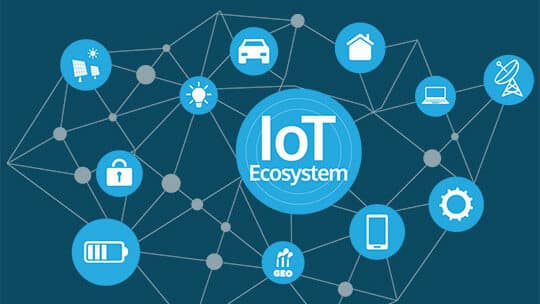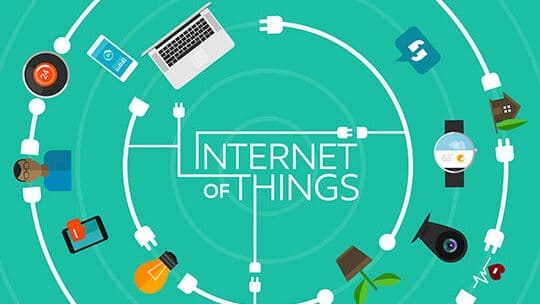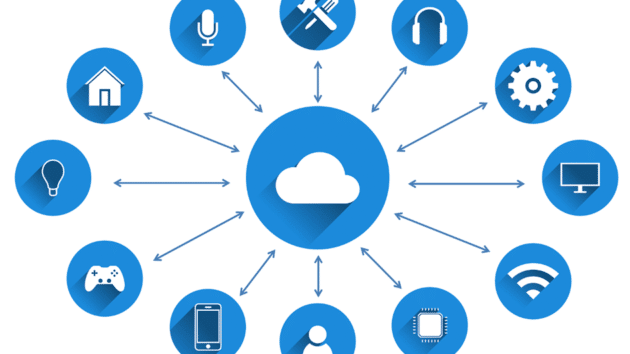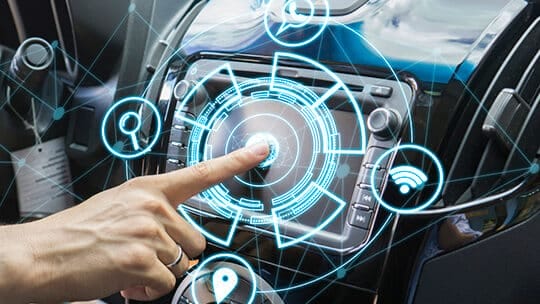Objects that are part of a network do not exist independently in space. Unless they are connected and fed into systems that generate data, a single sensor serves very little use, and a large number of them serve an even smaller one. We refer to this as an Internet of Things (IoT) ecosystem, which encompasses a wide variety of interconnected devices and technologies professionals use to accomplish a particular goal, such as developing a smart tech company. In addition, this ecosystem is used to achieve specific goals, such as developing a smart city.
We may speak about an endless number of parallel IoT ecosystems due to the limitless applications found for the Internet of Things. A basic paradigm emerges when the ecosystem is broken down into its most fundamental parts. Devices are responsible for collecting data, which is then sent via the network to a central hub, where it is aggregated and made accessible to agents. An IoT ecosystem is defined by its devices, networks, platforms, and agents as its fundamental components. Let’s get further into that subject and have a conversation about it.
What is IoT? What is the IoT ecosystem?

Before we can examine the ramifications of the internet of things for businesses, we first need to agree on a definition of it. The Internet of Things is a network of interconnected computing devices, physical objects, and software that enables the exchange of data, the automatic performance of tasks, and the facilitation of interactions and actions through artificial intelligence.
For those unfamiliar with the concept, the Internet of Things is best explained as follows: When one considers how much hardware, software, and applications connect and cooperate over the web and cloud storage, one realizes that this network is quite remarkable. Therefore, IoT’s focus on connectivity is a significant driver of the potential income it offers to organizations in the industry.
IoT for remote automation and administration of business processes and operations has recently seen a significant uptick. IoT software has a wide variety of potential applications, one of which is to connect and manage the mobile devices used by an organization from a single location. Because of this, you will have a much better understanding of how the various devices in your home connect to and use your networks.
In addition, with the assistance of this technology, it is possible to include security measures, manage data, and keep tabs on the firm’s assets. As a result, this technology can increase the efficiency and production of the business.
Recommended for you: 5 Most Promising IoT Business Trends to Follow in 2022.
Different components of the IoT ecosystem

In the same way that there are layers in the ecosystem of the planet, there are tiers in the ecosystem of the internet of things (IoT). To get started, you will want a layer that makes gathering and interpreting data from the Internet of Things devices easier. Then, you will need a mechanism for transmitting data over the internet. Finally, since most companies want to use the data for analytics purposes as well, it is essential to locate a method that can display the data in a manner that is beneficial to the user.
1. Sensors and Actuators

The sensors and actuators that gather data and take action based on that data are at the center of any Internet of Things system. For example, the micro-appliance, which takes the shape of a gadget connected to the Internet of Things, has sensors connected to tangible assets. The data collected by these sensors is then processed to provide signals or instructions to be followed by the actuator.
Following the receipt of the signal or instruction, the actuator “acts,” bringing about the occurrence of the desired result. One example of this would be an intelligent air conditioning system in a place of business that is set to maintain a certain temperature over the course of the working day. Sensors are used in the event that there is a change in temperature in the working environment in order to keep track of it. The actuators get a signal whenever a change is detected, and they respond by adjusting the flow of air in accordance with the new parameters.
2. Network

You could get the following conclusion after reading what you have: “Well, if an automatic door recognizes my presence and opens itself, is that the Internet of Things?” It is not because the door has sensors and actuators and is not connected to too many other things in the building. On the other hand, the Internet of Things is impossible to conceive of in the absence of both traditional things and the internet (although there are cases of data delivery without the use of the Internet Protocol). One may make the case that the power of this theory lies in the network effects it generates.
Connectivity options for Internet of Things devices range from “classics” like WiFi and Bluetooth to more specialized and field-oriented technologies like Low-Power Wide Area Networks. The best option for your organization will depend on the specifics of your deployment needs (LPWAN). Because of the different transfer rates and ranges that each option offers, certain deployments will be more suited to some alternatives than they would be to others.
Contrast an example such as a smart vehicle, which requires both high data speed and an extended range that we’ve been discussing, which doesn’t necessarily need either of those things.
You may like: Is IoT Shaping the Future of Web Development? Let’s Find Out!
3. IoT Cloud

The following phase, which comes after the capture of data and its transmission to the cloud, is analysis. A significant amount of “smart stuff” is now in the cloud. This high-performance facility serves as the primary glue that holds the Internet of Things ecosystem’s constituent parts together. It analyses the information, stores it, and then utilizes that information to decide whether or not a transaction should continue.
When it comes to the Internet of Things (IoT), time is of importance. This is especially true when it comes to matters of life and death, such as health and safety, where even a delay of milliseconds may have devastating effects.
Because of the time-sensitive nature of the Internet of Things model, there must be a component incorporated in IoT solutions for the purpose of data management. Cloud-based infrastructures may be the solution to this issue. The process, command, or in some other way account for analytics on the data that has been acquired, which makes them the primary nervous system of the infrastructure for the Internet of Things (IoT).
Integration of hardware, communication protocols, a central hub, and persistent storage makes it possible to analyze and interpret data quickly and on the go. Clouds, with their enormous processing powers, storage capacities, networking possibilities, analytic capabilities, and other service components, make information available to consumers in a manner that is both effective and efficient.
4. IoT Analytics and Data Management

Without data, your Internet of Things system will not be able to work properly. You cannot find your way through the ocean of analog data if you do not have IoT Analytics. You will need to have a good data management and analytics plan in place, whether your objective is to enhance the key performance indicators (KPIs) of a specific application or system or if your objective is to discover violations as they occur in real time.
The examination of data contributes to the elucidation of essential aspects of business, as well as to the assessment of the present circumstance and the formulation of a practical response. This information may provide several insights that can be used for trend prediction, long-term planning, and making decisions that are financially healthy for a firm.
Of course, a computer has to have a powerful processor and a huge quantity of memory in order to be able to store and process significant quantities of data. However, it is money well spent since it assists in the identification of game-changing company innovations, the forecasting of future trends, and the improvement of operational efficiency. Tasks connected to analytics could also be relocated there, depending on how your Internet of Things architecture is designed.
5. End-user Devices and User Interface

The user interface is the component of an Internet of Things device that users can see and interact with. The user interface is where they may adjust the system settings so that they are more to their taste. Therefore, the ease of use of a component of the Internet of Things ecosystem will directly correlate to the quality of the overall experience provided to a user. A person may interact with the system by using the device itself, or they can use a remote device such as a smartphone, tablet, or computer. Either way, they will be able to utilize the system.
Consumers now have the ability to engage in dialogue with their electronic gadgets because of the proliferation of smart home systems such as Amazon Alexa, Google Home, and others. In today’s fast-paced world, the design of a product is becoming more crucial, and a well-designed Internet of Things (IoT) device has the potential to stand out from the competition. Using different colors, typefaces, voices, and touch interfaces is vital in this context. While it is essential to have an interface that is pleasing to the eye, it should also be straightforward enough to ensure that the user does not have any difficulties using it.
You may also like: IoT App Development: Why Security for IoT Devices is so Critical?
Conclusion

It is difficult to generalize what an Internet of Things ecosystem involves since the components of an IoT ecosystem differ from deployment to deployment. There are a lot of different dynamic ecosystems on the Internet of Things, just as there are in the real world. However, one shared goal drives the development of these goods and services, from the engineers who create the hardware and software to the people who manage the networks and the IT departments.
Despite this, there is still a great deal of variety in this ever-changing environment. The technology, as shown by the devices, networks, and platforms, is continually improving. It is essential to remember this since taking it for granted is the single most catastrophic error anybody operating inside an IoT ecosystem may make. In such an atmosphere, stagnation and lock-in are particularly toxic, so you should always be on the lookout for innovative ideas that might assist you in thriving.
This article is written by Prashant Pujara. Prashant is the CEO of MultiQoS Technologies, a top node.js development company with experience in on-demand marketplace app development solutions where you can hire an iOS developer for your company. He oversees the company's commercial and delivery operations, as well as strategic planning and strategy. Follow them: LinkedIn | Facebook | Instagram | Twitter.
 This article is written by Prashant Pujara. Prashant is the CEO of
This article is written by Prashant Pujara. Prashant is the CEO of 




